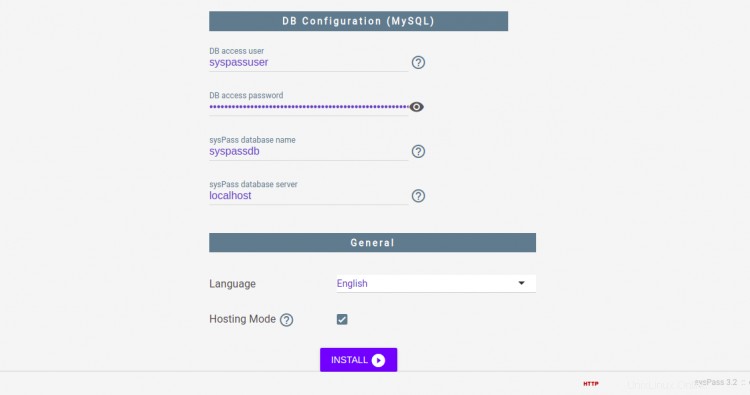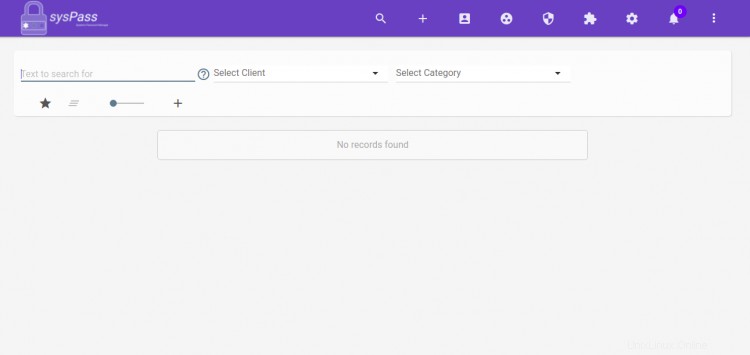sysPass es una aplicación de administración de contraseñas basada en la web escrita en PHP. Es seguro, confiable y se ejecuta en un entorno multiusuario para uso empresarial y personal. Guarda las contraseñas mediante cifrado bidireccional con una contraseña maestra en una base de datos. Proporciona una interfaz de usuario web intuitiva que lo ayuda a configurar opciones como autenticación LDAP, correo, auditoría, copia de seguridad, importación/exportación, etc.
Características
- Gratis y de código abierto
- Control de acceso a grupos/perfiles
- Cifrado de contraseña
- Almacenamiento de archivos con visor de imágenes en línea
- Integración de OpenLDAP y Active Directory
- Proporcionar notificación por correo electrónico
En este tutorial, le mostraré cómo instalar la aplicación de administración de contraseñas sysPass y cómo protegerla con un certificado Let's Encrypt SSL gratuito en Debian 11.
Requisitos
- Un servidor que ejecuta Debian 11.
- Un nombre de dominio válido apuntado con la IP de su servidor.
- Se configura una contraseña raíz en el servidor.
Instalar Apache, MariaDB y PHP
sysPass se ejecuta en un servidor web, utiliza MariaDB como base de datos y está escrito en PHP. Por lo tanto, deberá instalar el servidor web Apache, el servidor de base de datos MariaDB, PHP y otras extensiones de PHP en su servidor. Puede instalarlos todos usando el siguiente comando:
apt-get install apache2 mariadb-server libapache2-mod-php php php-mysqli php-pdo php-pear php php-cgi php-cli php-common php-gd php-json php-readline php-curl php-intl php-ldap php-xml php-mbstring git -y
Una vez que todos los paquetes estén instalados, edite el archivo php.ini y realice algunos cambios:
nano /etc/php/7.4/apache2/php.ini
Cambie las siguientes configuraciones:
post_max_size = 100M upload_max_filesize = 100M max_execution_time = 7200 memory_limit = 512M date.timezone = Asia/Kolkata
Guarde y cierre el archivo cuando haya terminado. A continuación, reinicie el servicio Apache para aplicar los cambios de configuración:
systemctl restart apache2
Crear una base de datos para sysPass
De forma predeterminada, la instalación de MariaDB no está protegida. Por lo tanto, deberá asegurarlo primero. Puede asegurarlo usando el siguiente comando:
mysql_secure_installation
Responda todas las preguntas como se muestra a continuación para establecer una contraseña raíz de MariaDB y asegurar la instalación:
Enter current password for root (enter for none): Switch to unix_socket authentication [Y/n] Y Change the root password? [Y/n] Y New password: Re-enter new password: Remove anonymous users? [Y/n] Y Disallow root login remotely? [Y/n] Y Remove test database and access to it? [Y/n] Y Reload privilege tables now? [Y/n] Y
Una vez que haya terminado, inicie sesión en la interfaz de MariaDB con el siguiente comando:
mysql -u root -p
Se le pedirá que proporcione una contraseña raíz de MariaDB. Una vez que haya iniciado sesión, cree una base de datos y un usuario con el siguiente comando:
MariaDB [(none)]> create database syspassdb;
MariaDB [(none)]> grant all privileges on syspassdb.* to [email protected] identified by "password";
A continuación, elimine los privilegios y salga del shell de MariaDB con el siguiente comando:
MariaDB [(none)]> flush privileges;
MariaDB [(none)]> exit;
En este punto, su base de datos MariaDB y el usuario están listos para sysPass. Ahora puede continuar con el siguiente paso.
Instalar sysPass
Primero, deberá descargar la última versión de sysPass del repositorio de Git. Puedes descargarlo usando el siguiente comando:
git clone https://github.com/nuxsmin/sysPass.git
Una vez completada la descarga, mueva el directorio descargado al directorio raíz web de Apache:
mv sysPass /var/www/html/syspass
A continuación, establezca la propiedad adecuada en el directorio syspass con el siguiente comando:
chown -R www-data:www-data /var/www/html/syspass
A continuación, establezca el permiso adecuado para los otros directorios:
chmod 750 /var/www/html/syspass/app/{config,backup} A continuación, deberá instalar Composer en su sistema.
Primero, cree un script de instalación de Composer con el siguiente comando:
nano /var/www/html/syspass/install-composer.sh
Agregue las siguientes líneas:
#!/bin/sh
EXPECTED_SIGNATURE="$(wget -q -O - https://composer.github.io/installer.sig)"
php -r "copy('https://getcomposer.org/installer', 'composer-setup.php');"
ACTUAL_SIGNATURE="$(php -r "echo hash_file('sha384', 'composer-setup.php');")"
if [ "$EXPECTED_SIGNATURE" != "$ACTUAL_SIGNATURE" ]
then
>&2 echo 'ERROR: Invalid installer signature'
rm composer-setup.php
exit 1
fi
php composer-setup.php --quiet
RESULT=$?
rm composer-setup.php
exit $RESULT
Guarde y cierre el archivo, luego ejecute el script de instalación de Composer usando el siguiente comando:
cd /var/www/html/syspass/
sh install-composer.sh
Una vez que Composer esté instalado, ejecute el siguiente comando para instalar todas las dependencias PHP requeridas:
php composer.phar install --no-dev
Una vez que todas las dependencias estén instaladas, puede continuar con el siguiente paso.
Configurar Apache Virtual Host para sysPass
A continuación, deberá crear un archivo de configuración de host virtual de Apache para alojar sysPass en Internet. Puedes crearlo usando el siguiente comando:
nano /etc/apache2/sites-available/syspass.conf
Agregue las siguientes líneas:
<VirtualHost *:80> ServerAdmin [email protected] DocumentRoot "/var/www/html/syspass" ServerName syspass.example.com <Directory "/var/www/html/syspass/"> Options MultiViews FollowSymlinks AllowOverride All Order allow,deny Allow from all </Directory> TransferLog /var/log/apache2/syspass_access.log ErrorLog /var/log/apache2/syspass_error.log </VirtualHost>
Guarde y cierre el archivo cuando haya terminado de activar el host virtual de Apache con el siguiente comando:
a2ensite syspass
A continuación, reinicie el servicio Apache para aplicar los cambios:
systemctl restart apache2
También puede verificar el estado del servicio Apache usando el siguiente comando:
systemctl status apache2
Deberías obtener el siguiente resultado:
? apache2.service - The Apache HTTP Server
Loaded: loaded (/lib/systemd/system/apache2.service; enabled; vendor preset: enabled)
Active: active (running) since Sat 2021-10-16 13:41:36 UTC; 4s ago
Docs: https://httpd.apache.org/docs/2.4/
Process: 17819 ExecStart=/usr/sbin/apachectl start (code=exited, status=0/SUCCESS)
Main PID: 17824 (apache2)
Tasks: 6 (limit: 2341)
Memory: 14.7M
CPU: 76ms
CGroup: /system.slice/apache2.service
??17824 /usr/sbin/apache2 -k start
??17825 /usr/sbin/apache2 -k start
??17826 /usr/sbin/apache2 -k start
??17827 /usr/sbin/apache2 -k start
??17828 /usr/sbin/apache2 -k start
??17829 /usr/sbin/apache2 -k start
Oct 16 13:41:36 debian11 systemd[1]: Starting The Apache HTTP Server...
Una vez que haya terminado, puede continuar con el siguiente paso.
Acceder a la interfaz de usuario web de sysPass
En este punto, sysPass está instalado y alojado en el servidor web Apache. Ahora, abra su navegador web y acceda a la interfaz web de sysPass usando la URL http://syspass.example.com . Será redirigido a la siguiente página:


Proporcione su nombre de usuario de administrador, contraseña, contraseña maestra, credenciales de la base de datos, elija su idioma, modo de alojamiento y haga clic en INSTALAR botón. Una vez que se haya completado la instalación, será redirigido a la página de inicio de sesión de sysPass.

Proporcione su nombre de usuario y contraseña de administrador y haga clic en > botón. Debería ver el panel de sysPass en la siguiente página:

Habilitar la compatibilidad con Let's Encrypt SSL en sysPass
Siempre es una buena idea proteger su sitio web con Let's Encrypt SSL. Primero, deberá instalar el cliente Certbot para instalar y administrar SSL. De forma predeterminada, el paquete Certbot se incluye en el repositorio predeterminado de Debian 11 para que pueda instalarlo con el siguiente comando:
apt-get install python3-certbot-apache -y
Una vez que Certbot esté instalado, ejecute el siguiente comando para proteger su sitio web con Let's Encrypt SSL:
certbot --apache -d syspass.example.com
Se le pedirá que proporcione su correo electrónico y acepte el término del servicio como se muestra a continuación:
Saving debug log to /var/log/letsencrypt/letsencrypt.log Plugins selected: Authenticator standalone, Installer None Enter email address (used for urgent renewal and security notices) (Enter 'c' to cancel): [email protected] - - - - - - - - - - - - - - - - - - - - - - - - - - - - - - - - - - - - - - - - Please read the Terms of Service at https://letsencrypt.org/documents/LE-SA-v1.2-November-15-2017.pdf. You must agree in order to register with the ACME server at https://acme-v02.api.letsencrypt.org/directory - - - - - - - - - - - - - - - - - - - - - - - - - - - - - - - - - - - - - - - - (A)gree/(C)ancel: A - - - - - - - - - - - - - - - - - - - - - - - - - - - - - - - - - - - - - - - - Would you be willing to share your email address with the Electronic Frontier Foundation, a founding partner of the Let's Encrypt project and the non-profit organization that develops Certbot? We'd like to send you email about our work encrypting the web, EFF news, campaigns, and ways to support digital freedom. - - - - - - - - - - - - - - - - - - - - - - - - - - - - - - - - - - - - - - - - (Y)es/(N)o: Y Plugins selected: Authenticator apache, Installer apache Obtaining a new certificate Performing the following challenges: http-01 challenge for syspass.example.com Enabled Apache rewrite module Waiting for verification... Cleaning up challenges Created an SSL vhost at /etc/apache2/sites-available/syspass-le-ssl.conf Enabled Apache socache_shmcb module Enabled Apache ssl module Deploying Certificate to VirtualHost /etc/apache2/sites-available/syspass-le-ssl.conf Enabling available site: /etc/apache2/sites-available/syspass-le-ssl.conf
A continuación, seleccione si desea redirigir o no el tráfico HTTP a HTTPS como se muestra a continuación:
Please choose whether or not to redirect HTTP traffic to HTTPS, removing HTTP access. - - - - - - - - - - - - - - - - - - - - - - - - - - - - - - - - - - - - - - - - 1: No redirect - Make no further changes to the webserver configuration. 2: Redirect - Make all requests redirect to secure HTTPS access. Choose this for new sites, or if you're confident your site works on HTTPS. You can undo this change by editing your web server's configuration. - - - - - - - - - - - - - - - - - - - - - - - - - - - - - - - - - - - - - - - - Select the appropriate number [1-2] then [enter] (press 'c' to cancel): 2
Escriba 2 y presione Entrar para instalar Let's Encrypt SSL para su sitio web:
Enabled Apache rewrite module Redirecting vhost in /etc/apache2/sites-enabled/syspass.conf to ssl vhost in /etc/apache2/sites-available/syspass-le-ssl.conf - - - - - - - - - - - - - - - - - - - - - - - - - - - - - - - - - - - - - - - - Congratulations! You have successfully enabled https://syspass.example.com You should test your configuration at: https://www.ssllabs.com/ssltest/analyze.html?d=syspass.example.com - - - - - - - - - - - - - - - - - - - - - - - - - - - - - - - - - - - - - - - - IMPORTANT NOTES: - Congratulations! Your certificate and chain have been saved at: /etc/letsencrypt/live/syspass.example.com/fullchain.pem Your key file has been saved at: /etc/letsencrypt/live/syspass.example.com/privkey.pem Your cert will expire on 2021-07-20. To obtain a new or tweaked version of this certificate in the future, simply run certbot again with the "certonly" option. To non-interactively renew *all* of your certificates, run "certbot renew" - If you like Certbot, please consider supporting our work by: Donating to ISRG / Let's Encrypt: https://letsencrypt.org/donate Donating to EFF: https://eff.org/donate-le
Conclusión
¡Felicidades! ha instalado correctamente el administrador de contraseñas sysPass con Apache en Debian 11. Ahora puede crear una cuenta diferente, agregar usuarios, acceder a privilegios e implementarlo en su entorno de producción.